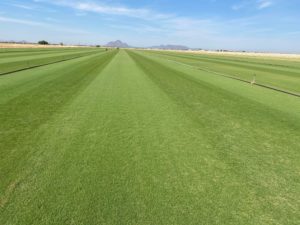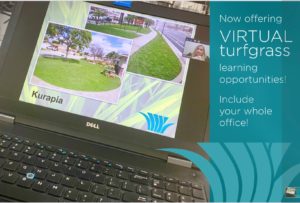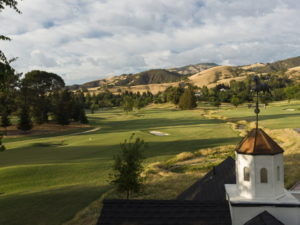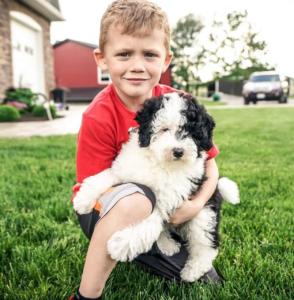Nov
You Have Overseeded Your California or Arizona Sod Lawn–Now What? And….Even if You Haven’t.
By now, most of you who are going to overseed your California or Arizona sod have either begun the process or have had your seed down for a few weeks. Today, I want to discuss what to do now that you have the ryegrass growing and cooler temperatures are on the horizon.
Getting your ryegrass up and growing is obviously the first step to a successful winter lawn, but what about maintenance? How can you make sure your ryegrass is strong going into the winter and you will have a full stand of ryegrass once the temperatures begin to drop into the 40’s at night? There are several key items associated with a strong winter lawn but early preparation should be high on your list.
I know you put down a starter fertilizer with your seed but let’s remember that fertilizer will move freely in a saturated soil. The new plant took up most of the nutrients from the starter fertilizer application but the residual affect is limited because you’ve been keeping the seed wet for the past few weeks. So what exactly does this mean? Basically, what I’m trying to say is that once you’ve had your ryegrass lawn in for 2-3 weeks I would advise getting a second fertilizer application on the grass.
Comments Off on You Have Overseeded Your California or Arizona Sod Lawn–Now What? And….Even if You Haven’t.Oct
The Case for Replacing Artificial Turf on NFL Fields
In September 2020, the NFL Players Association President, Cleveland Browns center JC Tretter called for all fifteen fields that are currently equipped with artificial turf to be replaced with natural turf to prevent further player injuries. In his letter titled “Only Natural Grass Can Level the NFL’s Playing Field”, he states “It’s not good for players, it’s not good for the GMs and the head coaches, it’s not good for the owners and it’s not good for the fans. Increased injuries are not good for anybody.” he continued as he detailed data to union members.
One of those artificial fields in question is MetLife Stadium, which has seen a bevy of injuries this season. Steelers’ right tackle Zach Banner suffered a torn ACL in Week 1 against the Giants, and running back James Conner also exited the game with an ankle injury. The following week, 49ers Nick Bosa and Solomon Thomas suffered injuries on the same field against the Jets. San Francisco defensive end Arik Armstead told the league to fix the “trash met life turf” after the game, and his coach Kyle Shanahan wasn’t thrilled either.
West Coast Turf Marketing Director, Danielle Scardino, spoke up to NBC recently to provide her professional opinion. “Natural turf has more give” and “There is no reason to have artificial turf, the technology exists even in colder climates to maintain the turf’s longevity.”
The first artificial turf-style field was introduced in the mid-1960s when ChemGrass was installed at the Houston Astrodome to replace the dying grass in the first domed stadium. The grass was later rebranded AstroTurf, and thus began the debate of natural grass versus turf playing surfaces.
For years, artificial turf, while very expensive, seemed like a good alternative to keep the turf looking great on camera for the NFL games and preserve the longevity of the surface. But recently, ten players were injured on these surfaces and two of them being season-ending injuries. This was enough to make the Players Association take notice.
On October 6, Casey Reynolds, PhD and Executive Director of Turfgrass Producers International responded in an open letter to the NFL Players Association, Team Owners, University and High School Athletic Directors, Sports Field Managers, Coaches, Athletes, and Parents “Do we want our athletes playing in a concert venue, or do we want to host concerts and other events in an athletic venue? If the answer is the latter, then there is little doubt that natural grass is the safest proven choice.”
According to Dr. Jennifer Nicole Falk from At Your Feet Concierge Podiatry, “Artificial turf not only increases the surface temperature, making it dangerous to play on at certain temperatures, it also puts players at increased risk for bacterial infections, as well as systemic effects and toxicity from the rubber… Because there is more friction between cleats and turf, this theoretically could lead to a greater potential for athletic injuries, including turf toe, knee injuries, foot lock, turf burn, and more powerful collisions & concussions.”
“Natural grass would give the players a safe work environment.” Danielle Scardino continued while speaking with NBC. “and we could get it done by next season”. West Coast Turf is the largest grower and installer of natural turfgrass sod in the Western United States.
West Coast Turf has supplied the NFL with eight Super Bowl fields from California to Florida, including Super Bowls XXVII, XXIX, XXX, XXXII, XXXVII, XXXVIII, XXXIX and 50 as well as baseball and soccer fields for professional sports teams.
The Truth About Artificial vs. Natural Turf
- Ground rubber tires are used in some artificial fields, yet because of their toxic content they are prohibited from being disposed of in landfills or ocean dumping. Where will this toxic material be disposed of when a replacement field becomes necessary?
- Temperatures on artificial fields have been documented to be upwards of 86.5 degrees hotter than natural grass fields under identical conditions. How long can players of all ages be safely exposed to this level of heat?
- Field sanitation that includes the removal of bodily fluids and/or animal droppings present a unique problem for artificial fields. Will antiseptic cleaners properly sanitize the field? If so, how often?
- Abrasive surfaces such as artificial fields can result in difficult-to-heal injuries, particularly in the presence of bacterial or viral pathogens. Are you prepared to treat these wounds properly?
- Field hardness on artificial surfaces can result in serious chronic or immediate athletic injury? If additional ground tire rubber is periodically added to soften the field, is toxicity of the material also renewed?
- Natural turf is preferred by 88% of NFL players, and 96% believe that artificial turf contributes to injuries.
- Natural turfgrass saves energy. The front lawns of eight houses have the cooling effect of about 70 tons of air conditioning. That’s amazing when the average home has an air conditioner with just a three or four ton capacity.
- Green turfgrass significantly lowers fire hazard risk. How would an artificial turf field fire be fought quickly while minimizing the danger to firefighters, and reducing the release of toxic fumes?
- The initial price of artificial turf is many times greater than a natural turf area. Maintenance costs are equal or higher.
Think Green-Keep it Real! Check out more #KeepItReal updates on Twitter.
Comments Off on The Case for Replacing Artificial Turf on NFL Fields
Oct
Frequently Asked Questions About Overseeding Your Warm Season Lawn
Now that we’re into October it’s time to get the overseeding of your warm season grass process started. I wanted to pass along some of the most frequently asked questions during this time of the year.
When is the best time to start overseeding?
Ideally overseeding should be done when nighttime temperatures are consistently in the 60’s. Usually this will be in October. There will be some higher and lower than normal temperatures, but anytime during October is good.
How low do I need to scalp the grass prior to seeding?
Height of cut isn’t as important as opening the turf canopy. The shorter you mow the grass, the tighter the turf canopy will be which will result in the need to verticut more aggressively. I recommend not going lower than ½”. There is no need to take the lawn to the dirt or you will cause long term problems to the grass plant.
Aug
Causes of patchy discolored grass on your lawn and how you can fix it.
The summer months of July through September can wreak havoc on your grass in high heat and humidity. If you see silver dollar size brown patches that occur in otherwise healthy lawns, the main cause is keeping the leaf surface continuously wet with daily waterings. Patches can run together forming larger patches that lose their circular shape. Grass dies back from the tip and fine white threads of fungus can be found on the patches in the early morning hours when the leaf surface is wet.
To minimize chances of disease, here are 5 things you can do:
-
Add Fertilizer: Low levels of fertility promote Dollar Spot; however, avoid applying high rates of Nitrogen, particularly in late spring and summer
-
Watering: Water during early AM hours to allow grass leaves all day to dry off
-
Don’t over-water: Avoid frequent irrigation that keeps the leaf blades wet and that results in water-logged/compacted soils
-
Let it grow: Mow at the upper end of recommended mowing heights (but not above recommended mowing heights)
-
Don’t compact: Avoid wet compacted soils
If you suspect your lawn has a deeper issue, you can spray on a fungicide labeled for Dollar Spot. Repeat every 10 days until symptoms are gone… ALWAYS READ & FOLLOW LABELED DIRECTIONS.
You’re in luck if you have West Coast Turf’s exclusive West Coaster sod, as patchy discolored grass is less common and it makes for the ultimate lawn for coastal and cooler climates. West Coast Turf’s special blends of fescue are the best performing in the industry.
Cool season grasses thrive in climates with more annual rainfall and cooler year round temperatures. This includes coastal areas of California and high elevation mountainous areas with cooler temperatures. Cool season grasses are not suitable for hot desert climates. West Coast Turf grows the highest quality cool season grasses such as our unique West Coaster Tall Fescue which is our professional blend of fescue and other seed to avoid disease and keep a happy, healthy, and resilient lawn for your home.
West Coaster Tall Fescue is uniquely selected to avoid disease and performs well with light traffic, making it the perfect lawn for your home. However, if you do experience any spots, you can patch it with our West Coaster Seed.
Now you, too, can use the same seed we use to grow our popular West Coaster tall fescue sod for your own home use! Use our new 10 lb bag of seed to “sweeten up” or patch repair your West Coaster established sod lawn, or seed a new lawn with our exclusive seed.
-
The new generation of Tall Fescue
-
Light to heavy traffic lawns
-
Year-Round Green
-
Performs well in coastal California, as well as cool inland valley and high desert environments
-
Deep root system ensures drought and heat tolerance
-
Emerald green color. Natural dark green color means less nitrogen is required
-
Uses less water
-
Superior resistance to drought, insects, and disease
-
Tolerant of saline soils and saline irrigation water
-
Heat tolerant up to 100 degrees F
-
Moderately shade tolerant—requires full sun most of the day (4-10 hours)
-
7-10 day germination time with proper planting and care
-
Mowing 1”-3”
Keeping your lawn healthy doesn’t have to be a chore, but it does require patience and care. Stay cool! Please visit us online: https://www.westcoastturf.com/
Aug
Late Summer Sod Tips for California and Arizona Lawns
Summer Sod Tips for California and Arizona Lawns
Summer is wrapping up, the kids are heading back to school, and I’m sure you’re ready to come out of hibernation. While the summer heat is far from over in Arizona and California, it’s going to become tolerable outside. With the slightly cooler mornings it’s time to get back outside and get your lawn ready for fall. Most people start thinking about overseeding their California and Arizona sod in September, but ideally you wouldn’t start the process until October when nighttime temperatures get into the 60’s. Between now and then there are some important steps you need to do to get your lawn ready and to save some headaches down the road.
Between May and September you’ll probably notice your lawn has grown at twice the rate it does during the winter months. Warm season grasses love the warm, wet weather. Most people thought the hot weather would keep the grass from growing well, but remember warm season grasses optimal growing temperatures are between 90-105 degrees. During this season any of your weaker areas should have filled in with the warm season grasses runners. These spots can be slow to fill in during the dry, hot days but as soon as the humidity kicks in the grass really takes off. If you still have large open spots I would suggest picking up a few rolls of sod and patching them prior to overseed. You don’t want to seed directly into the soil.
During the summer months you’re getting lots of new growth on the grass plant and you need to help it thrive. The best way to do this is to thin out the top growth by using a verticut or power rake. Most people only use one during the overseed season but it’s a vital part of promoting new growth during the summer months. When you get too much top growth the grass will get clumpy and keep your new plants from growing. A verticut or power rake will open the turf canopy and thin out the grass plant. Doing so will promote new plant growth. This will also allow you to mow your lawn shorter without scalping. Set the power rake or verticut about halfway down and run over the entire lawn. You can easily mow or rake up the material. Keep in mind that by thinning it now you will save yourself hours of labor during overseed. If you wait until overseed to thin your lawn you may need to repeat this process several times.
For the next month you don’t want to promote top growth unless you don’t plan on overseeding this fall. The more material you have, the more material you will need to remove during overseed. I like to stick to slow release nitrogen products or products that will promote root growth during late summer. There are lots blends that will work but phosphorus and potassium will help your roots at this time of the year.
It’s still too hot to really cut back your water but during the wet periods you can let the lawn stress before you turn the irrigation system back on. Let the lawn go until you see some bluish grey spots appearing in the lawn. These areas aren’t dying but they are stressed. When you see these spots you know it’s time to water again. You can start to back your water down in mid-September when the nights cool off a little more.
If you’ve had persistent weed issues during the winter months you can apply Prodiamine. One product that a lot of people use is Barricade. This must be used 7 weeks prior to overseed. Keep in mind you must wait 7 weeks after you spray this product before you overseed. For the first two weeks of overseed you will need to keep the seed a little more wet than usual so the roots of the new plant can break through the Barricade layer. If you sprayed this week it would have you overseeding in the middle of October which is perfect. The best overseeding period is typically from October 7th-October 31st. Any time you seed during this time frame you will have very little competition from the underlying warm season grass. If you go earlier be prepared for the warm season grass to come back and be actively growing while you’re watering the ryegrass seed.
One way to keep the warm season grass in check is through applications of plant growth regulators such as Trinexapacethyl. One such product that many use is Primo. This can be applied 5-7 days prior to overseeding at .5 oz/1000 SF and right after the first mowing at .35 oz/1000 SF. If you seed during the normal window in October you can skip this step unless you have a very lush, over fertilized lawn going into fall. This is not an endorsement of these products but a generic list of products you can try.
The final thing you can do is mow a little lower for the next few weeks and reduce the turf density. Right before overseed I will tell you to let the grass grow up about 30-40% prior to scalping but you have over a month until you need to worry about it.
Remember when you start to see seed in the stores you want to find a perennial ryegrass that is weed free, and has a high germination rate. Many of the products you will see will be cheap in cost and won’t provide you with a dark green lawn during overseed. I will put out overseed instructions in September as we get closer to the season.
If you have any questions, please hit the “Ask Jay” button at the top right of this page.
Till next time,
Jay
Comments Off on Late Summer Sod Tips for California and Arizona Lawns
Aug
Attention Landscape Architects! We Are Now Offering ZOOM Educational Opportunities!
These are trying times, but that doesn’t mean we have to stop learning. West Coast Turf is now offering virtual Zoom educational opportunities for landscape architects!
Include your whole office! Find out about the newest varieties including the exciting Kurapia sod natural turfgrass alternative ground cover. It’s drought tolerant, unique, versatile, and beautiful. There are some great new native grasses that look spectacular. We also can update you on our old standbys such as West Coaster Fescue, Santa Ana, Bandera Bermuda, and Tifgreen that are tried and true.
Call or e-mail us today to schedule your presentation–760/340-7301 or danielle@westcoastturf.com. The presentation takes about an hour, and we are able to answer any questions you might have on natural turfgrass varieties or Kurapia sod ground cover for your next project.
We miss you and are excited to “see” you again virtually! Contact us today!
Comments Off on Attention Landscape Architects! We Are Now Offering ZOOM Educational Opportunities!Aug
Diablo CC Returns to the Golden Age (using West Coast Turf’s Santa Ana and Bandera Bermuda!)
Jul
Avoid overheating your Arizona & California sod in Summer.
In the middle of July, our California and Arizona desert weather can be brutal and if you are getting ready to receive your new sod, you need to make sure to avoid overheating your sod. Sod is a delicate product that is perishable and sod rolls can burn within a few hours if they aren’t installed in a timely manner.
Here are 5 tips to avoid overheating your sod in summer.
- PREPARE THE SOIL- Having your sod delivered after your soil is completely ready is imperative. The shorter the time between harvest and installation, the better. On a very hot day, a pallet of sod can overheat in as little as 4 hours.
- DO NOT WATER WHILE ROLLED – It may seem like a good idea, but watering your rolled sod will actually accelerate the heating process. Your grass is still growing, which releases nitrogen, which will heat up and kill the grass. So, watering may cool it down temporarily, but accelerates growth and therefore overheating.
- SHADE IS KEY – Store your sod while on the pallets in a shady spot. Take into consideration how long that area will remain shady while you are installing.
- INSTALL ASAP – Install immediately after delivery. On a super hot day, the middle of the pallet will be similar to an oven. If need be, pull the sod rolls off and spread them out to allow air to flow while still safely in your shady location.
- WATER AWAY – Sod can still overheat if it isn’t watered within 6 hours after harvest. As soon as you have enough sod laid out, start with a sprinkler sized area as soon as it’s laid out. Follow our Summer watering schedule for the best results.
So why does sod overheat? During harvest, sod is rolled and stacked on a pallet for easy transport. This is a convenient way to move a large amount of sod, but it has its drawbacks during the summer months or even a hot spring day! While your sod is cut from the ground, it’s still very much alive and continuing to grow. It’s delicate, yet hearty and the most important thing to remember is that it is a perishable product. When your sod is rolled up and stacked, there is no airflow to it, which is an essential factor in sod establishment, but your grass (like most other plants) needs oxygen to survive.
Another factor in overheating is pressure. That sod stacked up is heavy! The quicker you can get it out of a pile, the better. It’s similar to walking on fresh sod, that weight can be damaging.
The third factor in overheating sod is heat, which is obvious. So, keeping your sod in shade and installed & watered as soon as possible will avoid the overheating your sod.
Need help determining what type of soil your lawn has or how much summer watering a specific turf grass variety requires? Ask Mr.WiseGrass! To stay updated on all things sod related, you can also sign up for our newsletter. Happy summer!
Comments Off on Avoid overheating your Arizona & California sod in Summer.May
Home Improvements During Shelter At Home Order
COVID-19 has flipped the world on its head and there’s no getting around how much our way of life has changed in the past few months. Even for those who are still working full time, most are finding they have a lot of free time on their hands. One productive way to channel this energy is through home improvement projects, specifically ones that allow you to be outside enjoying the sun and the beautiful late spring weather. One fantastic hobby to hone in on is gardening and landscaping. Nothing sets off your garden and your home like a lush, green lawn. In achieving this, natural turf is always the way to go. A beautiful Arizona or California sod lawn is the perfect background for entertaining and outdoor sports as well. A natural turf lawn gives off oxygen, draws in carbon dioxide, and helps keep air temperatures cooler in the summer. Artificial turf seems appealing, as it stays green and requires little care, but this can be deceiving, as there are many drawbacks. Artificial turf gets unbearably hot in the summer months and is known to contain antimicrobials, which are often toxic. In desert climates, you and your pets can enjoy your natural sod lawn without fear of burning your feet (and your pet’s paw pads), since natural turf stays 20-50 degrees cooler than artificial turf (which is also hard to completely sanitize). To get started with a California or Arizona sod lawn, contact us at West Coast Turf, where our knowledgeable team will direct you to what natural turf works best for your landscaping. Please note that due to California and Arizona’s statewide shelter at home orders, West Coast Turf is carefully and responsibly continuing to operate using heightened hygiene and social/physical distancing rules
All orders must be prepaid on the phone or website and will be delivered without any contact. As always, we appreciate and value our loyal customers.
Please visit us online: https://www.westcoastturf.com/
Comments Off on Home Improvements During Shelter At Home OrderApr
Getting Your Lawn in Top Shape During Spring Transition
**Due to California and Arizona’s statewide shelter at home orders because of the coronavirus, West Coast Turf is carefully and responsibly continuing to operate using heightened hygiene and social/physical distancing rules to maintain the health and safety of our employees and customers.
We are monitoring available information and are able to continue to supply sod since it’s an agricultural product, and supply hardware stores, nurseries, and construction, which are listed as exempt from the order.
All orders must be prepaid on the phone or website. Orders will be delivered without any contact, and know that we appreciate and value our loyal customers.
Please be aware that this could change at any time if further clarification is given by either State. We are open and here to help you with your turfgrass needs.**
___________________________________
A lot of us have some extra time at home right now, and are spending more time out on our California and Arizona lawns.
There’s a renewed appreciation for nature and the outdoors. And, the sight of green grass and the smell of fresh cut grass has proven to be beneficial to our mental health and help curb anxiety–that’s ALWAYS welcome–especially now.
Taking care of your lawn can be productive, therapeutic, and something you can do alone, or with someone else safely and socially distant.
Let’s talk about some things you can do right now to make sure your lawn transitions properly this spring……
Spring Transition
As the temperatures begin to rise it’s a good time to look at your lawn program. Did you overseed your warm season lawn or allow it to bounce into dormancy (*jump to the bottom of the page for a dormant lawn)? Either way there are some important items to remember so you have a healthy, lush lawn all year long. It’s still a little early to see the full effects of transition. If you plan right your transition will be seamless.
Transition typically occurs in April and May, but being proactive now can speed up the process. For anyone that’s gone through a spring transition you’ve probably learned the worst mistake is to start too late.
Comments Off on Getting Your Lawn in Top Shape During Spring Transition





